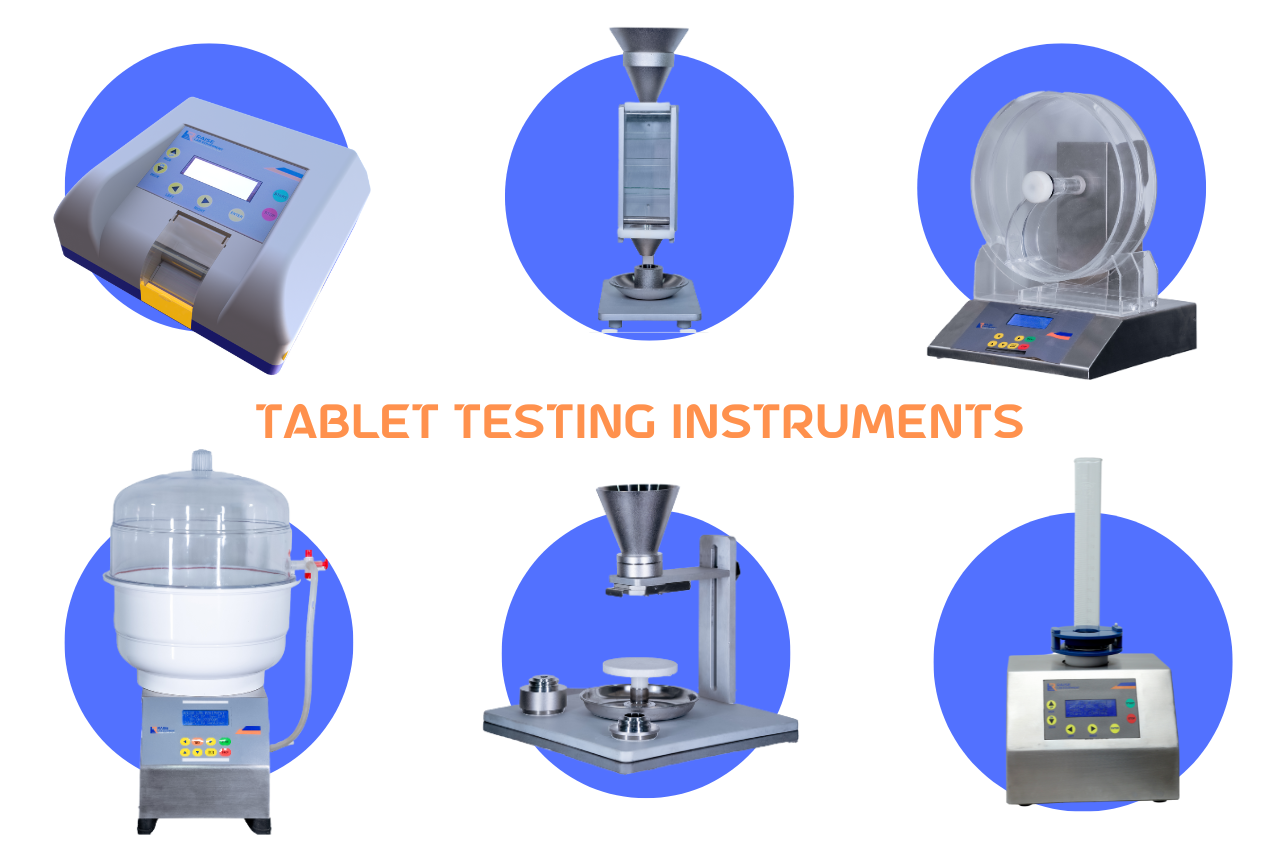Tablet testing is a crucial aspect of pharmaceutical manufacturing to ensure the quality, safety, and efficacy of oral dosage forms. In India, the pharmaceutical industry adheres to global standards, with the United States Pharmacopeia (USP) providing guidelines and procedures for various tests. In this comprehensive guide, we will delve into the procedures and criteria outlined in the USP 1-Aug-2019 for uncoated or plain-coated tablets, delayed-release tablets and capsules, buccal tablets, sublingual tablets, capsules, tablets for oral suspension, tablets for oral solution, tablets for topical solution, orally disintegrating tablets, and chewable tablets. Additionally, we will explore the procedures and criteria for effervescent tablets for oral solution and effervescent granules, emphasizing the importance of tablet testing instruments in this process.
Tablet Testing Instruments: An Overview
The reliability and accuracy of tablet testing heavily rely on advanced testing instruments. Here are key instruments used in the tablet testing process:
- Importance: Measures the resistance of a tablet to crushing or fracturing.
- Procedure: Tablets are subjected to controlled compression until they break or fracture. The hardness tester provides a numerical value indicating the tablet’s strength.
- Criteria: Tablets should exhibit a hardness within the specified range, ensuring they withstand handling and transportation without breaking.
2. Tablet Friability Tester:
- Importance: Evaluates the durability of tablets during handling, packaging, and transportation.
- Procedure: Tablets are placed in a drum that rotates, causing repeated impacts. After a set duration, the tablets are weighed to determine the percentage of weight loss.
- Criteria: The percentage of weight loss should be within acceptable limits, indicating the tablets’ ability to withstand mechanical stress.
3. Tablet Disintegration Tester:
- Importance: Assesses the time taken for tablets to disintegrate into small particles, aiding in drug absorption.
- Procedure: Tablets are placed in a disintegration apparatus, and the time required for complete disintegration is recorded.
- Criteria: All tablets should disintegrate within the specified time, ensuring effective drug release.
4. Tablet Dissolution Tester:
- Importance: Determines the rate at which the active pharmaceutical ingredient dissolves from the tablet.
- Procedure: Tablets are placed in dissolution vessels filled with a specified medium, and the dissolution process is monitored.
- Criteria: The dissolution profile should meet predefined specifications, ensuring optimal drug release.
5. Package Integrity Tester:
- Importance: Ensures the integrity of tablet packaging, preventing exposure to external factors.
- Procedure: Utilizes various methods, such as vacuum decay or pressure decay, to identify leaks in the tablet packaging.
- Criteria: Packages should exhibit integrity, protecting tablets from environmental influences.
6. Antibiotic Zone Reader:
- Importance: Used in microbiological testing to measure the zone of inhibition in antibiotic susceptibility testing.
- Procedure: Measures the diameter of zones formed around antibiotic discs on agar plates.
- Criteria: Results are compared with established standards to determine antibiotic effectiveness.
7. Scott Volume Meter:
- Importance: Measures the bulk volume of granular materials, providing insights into powder flow characteristics.
- Procedure: Granules are poured into a calibrated container, and the volume occupied is measured.
- Criteria: The Scott volume should align with predefined standards, indicating suitable flow properties.
8. Tapped Density:
- Importance: Assesses the powder’s compaction and packing properties.
- Procedure: Measures the volume of powder after tapping to a specified extent.
- Criteria: Tapped density values should be within the acceptable range, indicating proper powder compaction.
9. Sieve Shaker Machine:
- Importance: Determines the particle size distribution of granular materials.
- Procedure: Granules are placed on sieves, and the machine shakes or vibrates to separate particles based on size.
- Criteria: The resulting particle size distribution should meet defined specifications for the intended formulation.
Incorporating these instruments into the tablet testing process ensures the consistent quality and performance of pharmaceutical tablets, meeting regulatory standards and safeguarding patient health.
In the highly regulated pharmaceutical industry, tablet testing is a critical step in ensuring the quality and efficacy of oral dosage forms. Adhering to the procedures and criteria outlined in the USP 1-Aug-2019 is essential for pharmaceutical manufacturers in India. Tablet testing instruments play a pivotal role in this process, providing accurate and reliable data on various parameters such as hardness, friability, disintegration, dissolution, and package integrity.
Conclusion:
Investing in state-of-the-art tablet testing instruments, including tablet hardness testers, friability testers, disintegration testers, dissolution testers, package integrity testers, antibiotic zone readers, Scott volume meters, tapped density instruments, and sieve shaker machines, is imperative for pharmaceutical companies aiming for excellence in their manufacturing processes.
By emphasizing the importance of these instruments and adhering to stringent testing procedures, the pharmaceutical industry in India can continue to produce high-quality tablets that meet global standards, ensuring the safety and well-being of patients consuming these medications. The incorporation of advanced tablet testing instruments is not only a regulatory requirement but also a commitment to delivering pharmaceutical products that consistently meet the highest quality standards.


